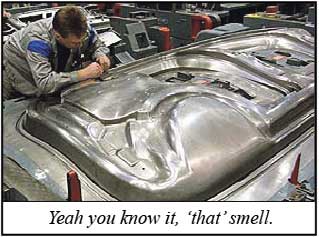
Have you ever wondered what buying a new car may have to do with cancer? Well, recently environmental sleuths have come to believe that there is such a thing as “sick car syndrome” and similar to sick building syndrome. When one stops to think about all the chemicals and toxic materials used in the manufacture of the interior or cabin of a vehicle, maybe there is more to the cancer connection than we think.
For example, did you know that bromines and antimony commonly are used as flame retardant chemicals in upholstery and carpets that go into cars but also in your bedroom mattresses and upholstered furniture. In animal studies, bromides have been linked to behavioral and neuro-developmental problems, including ADD/ADHD in children,
Antimony, a metalloid [an element that has some properties of metals but is not a metal] is used in the manufacture of paints and enamels, ceramics, numerous alloys and rubber, and is a common component in electronics.  Poisonous and toxic mercury is used in manufacturing polymers—and plastic is a polymer!!!
Poisonous and toxic mercury is used in manufacturing polymers—and plastic is a polymer!!!
The inside of the cabin is filled with plastic. And in the summer’s heat it gases out tremendous amounts of vapors which some call the “new car smell.” The US Environmental Protection Agency has a web site devoted to handling toxic mercury and still this heavy metal is being used in the manufacture of cars, dental amalgams (silver fillings) and as a preservative (Thimerosal) in vaccines injected into young and old alike. Gimme a break.
Currently our world is being “plasticized.” Plastics contain many “ingredients” and the most commonly used are chlorine and lead in the manufacture of PVC (polyvinylchloride plastic) together with phthalates [compounds of phthalic anhydride and alcohol that don’t evaporate easily and gas out] to make it soft or pliable. Is it any wonder that we now have “sick car syndrome”?
So what does all this have to do with cancer? According to the American Cancer Society’s 2007 Cancer Facts & Figures report, “Cancer risks and rates may also be influenced by cultural and genetic factors that decrease or increase rates.” Nothing is more cultural than everyone has to have his or her own vehicle—and preferably, showroom brand new!
Bold face and upfront the ACS report admits, “Environmental (as opposed to hereditary) factors account for an estimated 75% - 80% of cancer cases and deaths in the U.S.” However, it states that tobacco smoking purportedly contributes to 30% of the cancer burden.
Take a look at those odds!
Any odds maker in Las Vegas—or anywhere for that matter—would steer away from making a bet when presented with what the ACS says about environmental factors influencing cancer. And, the 2007 statistics for cancer were equally alarming: 1,444,970 new diagnoses with a projected 559,650 deaths from cancer. What are we doing to ourselves?
Why are we allowing ourselves to be made sick by businesses, industries, and a medical profession that will not come down hard on the chemical industry? Can it be because the medics are in bed with the pharmaceutical industry? Are physicians the “dogs being wagged by the tail”? Or is it because everyone involved in modern medicine today—from the U.S. FDA to the pharmaceutical industry to practicing physicians—knows that if man-made chemicals are exposed for their rightful place in the breakdown of health—and cancer in particular—the pharmaceutical industry and modern medicine will see the basis of their professions—chemicals—fall apart like a house of cards? After all, didn’t someone once say, “You can’t poison a body into wellness.” When will we realize that? Maybe we can learn something from our beloved automobiles after all. They are making us sick.